Analyzing Google's Organizational Culture and Its Impact on Business
VerifiedAdded on 2020/10/22
|11
|3263
|345
Report
AI Summary
This report provides an executive summary and analysis of Google's organizational culture, focusing on its impact on employee motivation, communication, and overall business performance. The report is based on primary research, including interviews with Google managers and employees, exploring key aspects of the company's culture. The research is complemented by secondary research, discussing relevant theoretical models like Edger Schein's Model of Organizational Culture and the Shannon Weaver model of communication, and their application within Google. The report highlights how Google's culture fosters innovation, improves employee skills, and enhances leadership, ultimately contributing to its competitive advantage. It examines the artifacts, values, and assumptions that shape Google's unique environment and communication strategies, including the use of the Shannon Weaver model for both internal and external communications. The report concludes with a discussion of how Google's culture affects employee self-esteem and provides recommendations for continuous improvement. This document is contributed by a student to be published on Desklib.
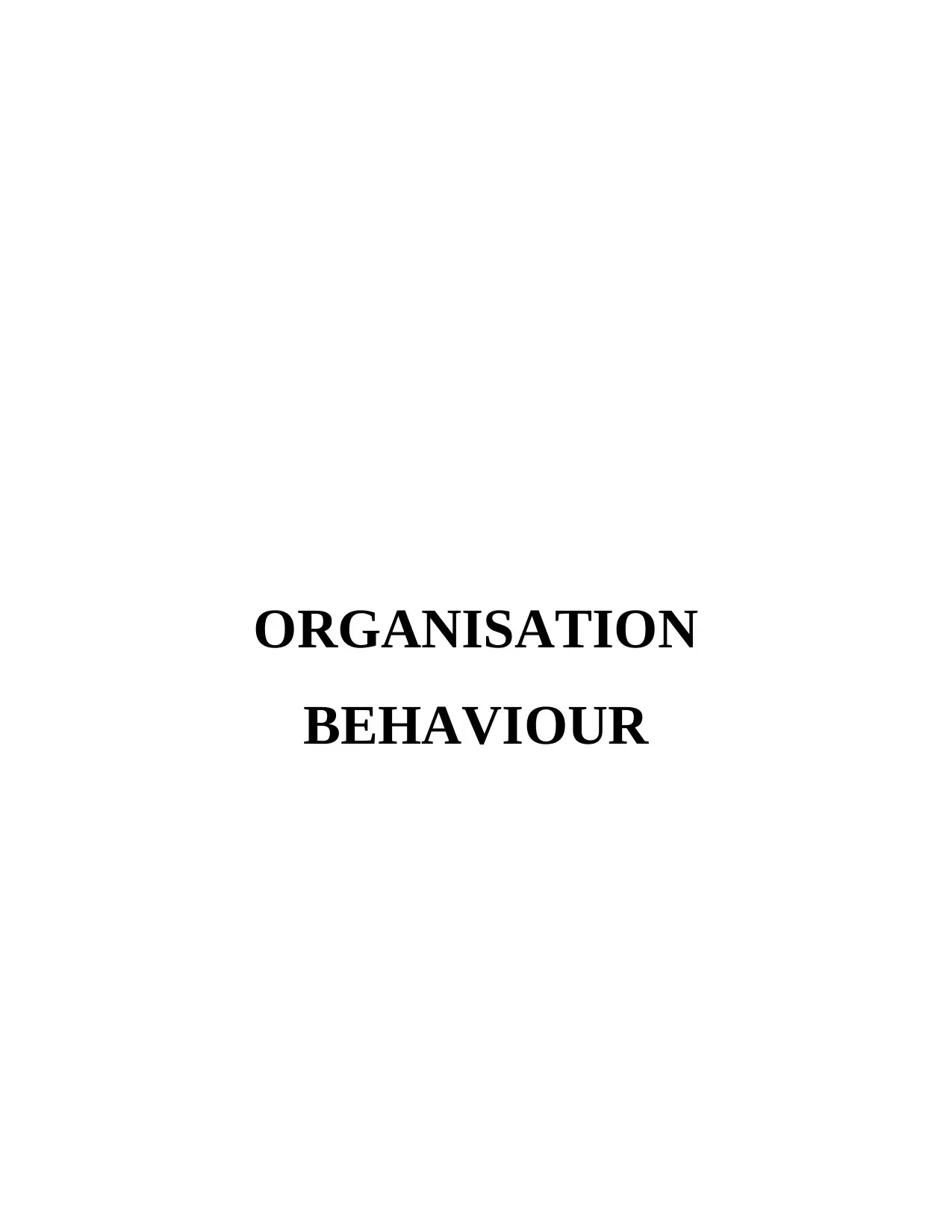
ORGANISATION
BEHAVIOUR
BEHAVIOUR
Paraphrase This Document
Need a fresh take? Get an instant paraphrase of this document with our AI Paraphraser
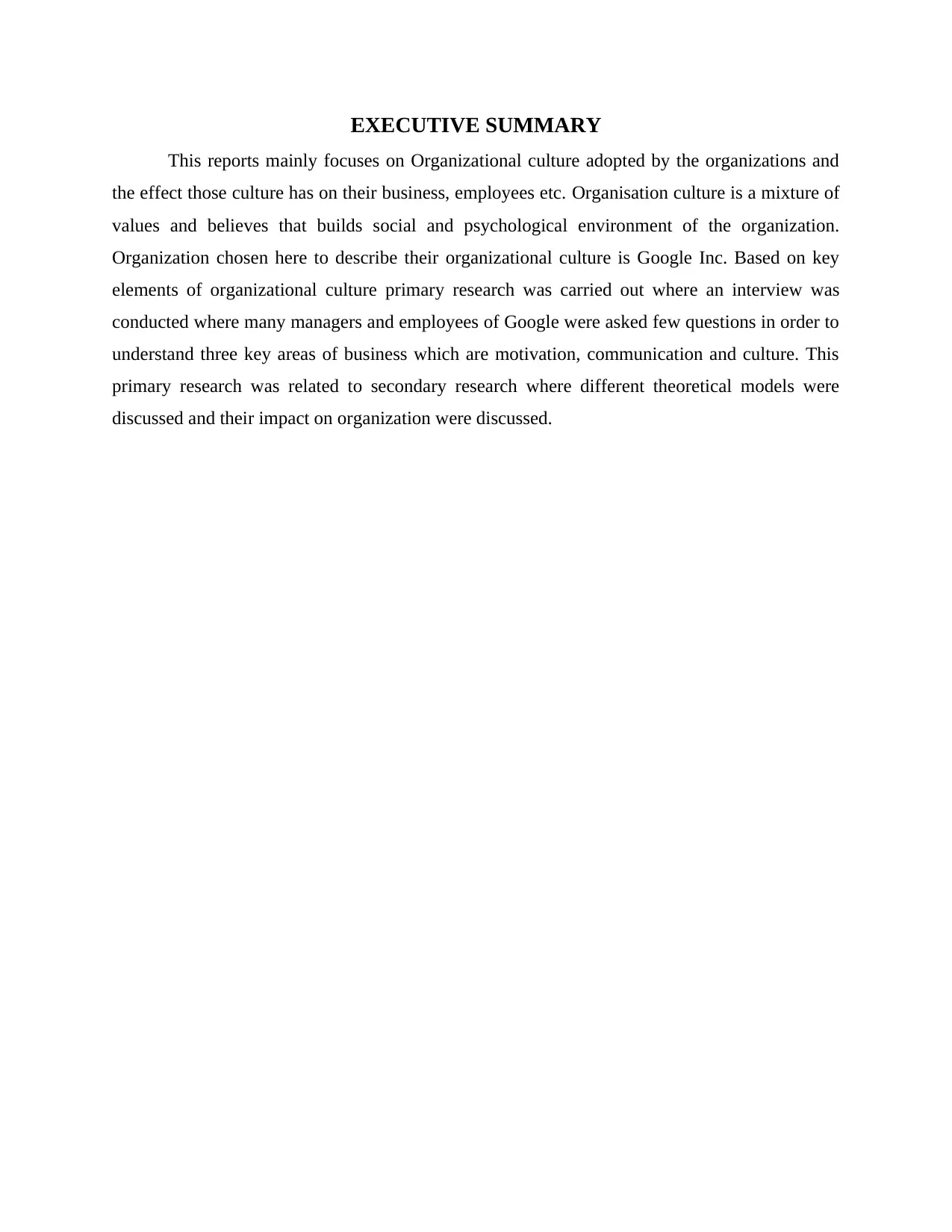
EXECUTIVE SUMMARY
This reports mainly focuses on Organizational culture adopted by the organizations and
the effect those culture has on their business, employees etc. Organisation culture is a mixture of
values and believes that builds social and psychological environment of the organization.
Organization chosen here to describe their organizational culture is Google Inc. Based on key
elements of organizational culture primary research was carried out where an interview was
conducted where many managers and employees of Google were asked few questions in order to
understand three key areas of business which are motivation, communication and culture. This
primary research was related to secondary research where different theoretical models were
discussed and their impact on organization were discussed.
This reports mainly focuses on Organizational culture adopted by the organizations and
the effect those culture has on their business, employees etc. Organisation culture is a mixture of
values and believes that builds social and psychological environment of the organization.
Organization chosen here to describe their organizational culture is Google Inc. Based on key
elements of organizational culture primary research was carried out where an interview was
conducted where many managers and employees of Google were asked few questions in order to
understand three key areas of business which are motivation, communication and culture. This
primary research was related to secondary research where different theoretical models were
discussed and their impact on organization were discussed.
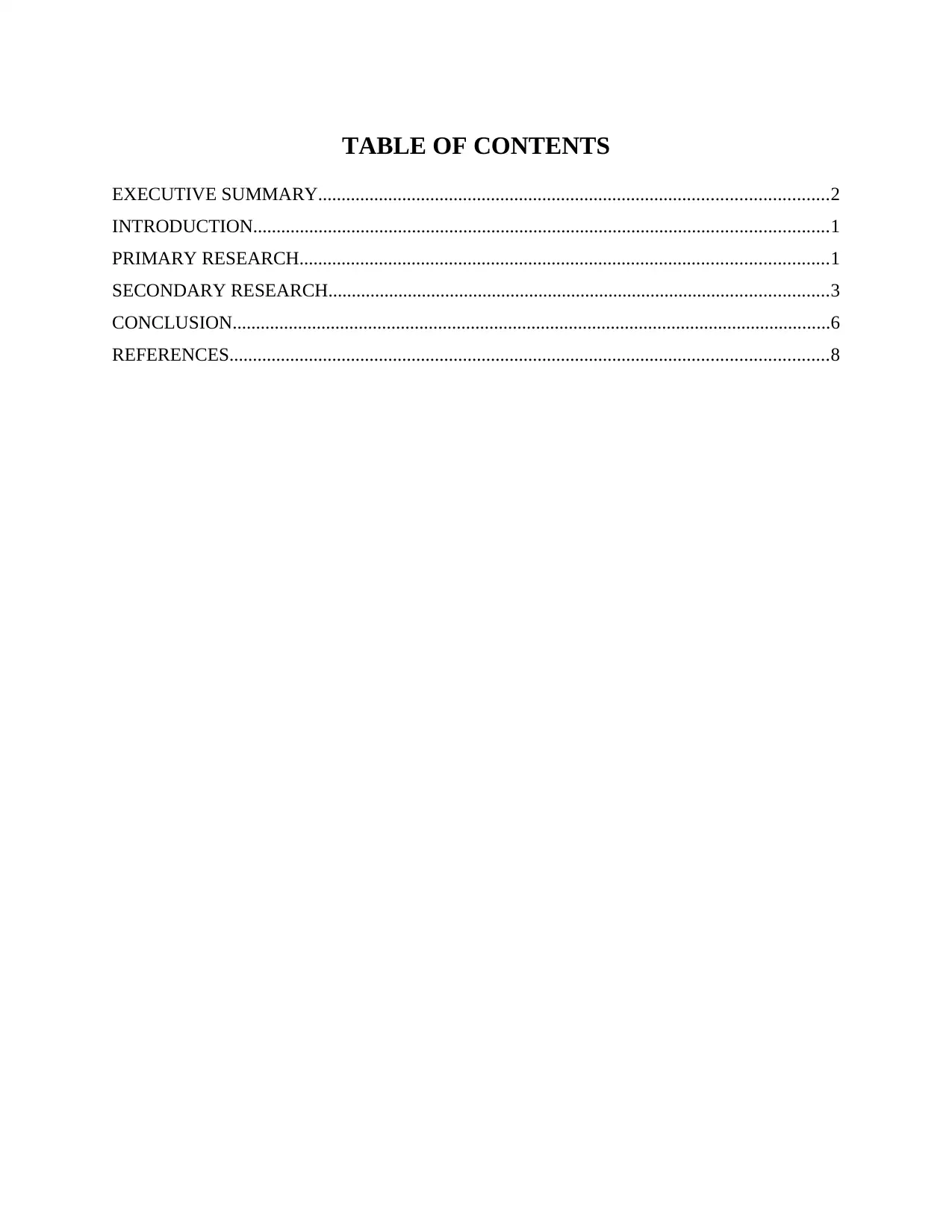
TABLE OF CONTENTS
EXECUTIVE SUMMARY.............................................................................................................2
INTRODUCTION...........................................................................................................................1
PRIMARY RESEARCH.................................................................................................................1
SECONDARY RESEARCH...........................................................................................................3
CONCLUSION................................................................................................................................6
REFERENCES................................................................................................................................8
EXECUTIVE SUMMARY.............................................................................................................2
INTRODUCTION...........................................................................................................................1
PRIMARY RESEARCH.................................................................................................................1
SECONDARY RESEARCH...........................................................................................................3
CONCLUSION................................................................................................................................6
REFERENCES................................................................................................................................8
⊘ This is a preview!⊘
Do you want full access?
Subscribe today to unlock all pages.

Trusted by 1+ million students worldwide
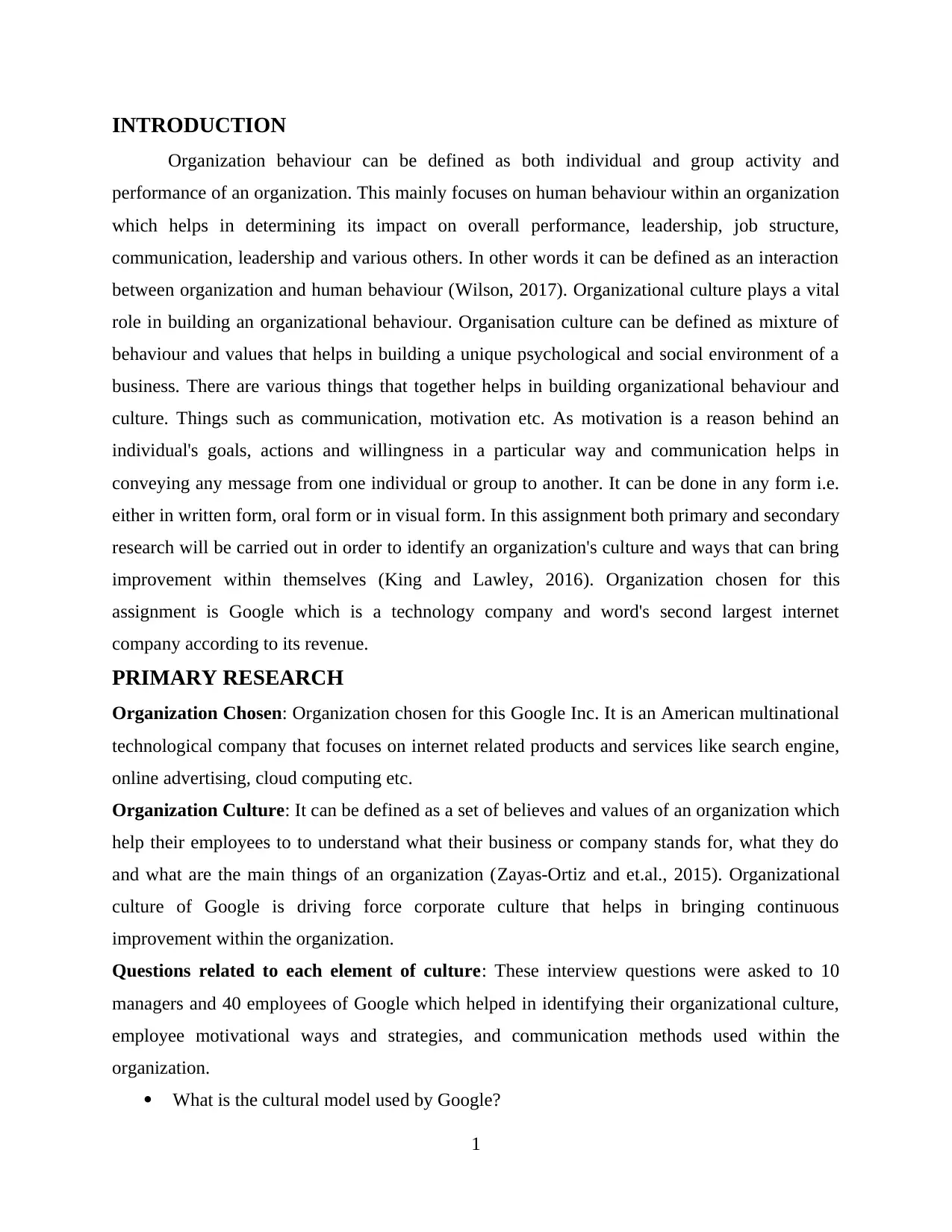
INTRODUCTION
Organization behaviour can be defined as both individual and group activity and
performance of an organization. This mainly focuses on human behaviour within an organization
which helps in determining its impact on overall performance, leadership, job structure,
communication, leadership and various others. In other words it can be defined as an interaction
between organization and human behaviour (Wilson, 2017). Organizational culture plays a vital
role in building an organizational behaviour. Organisation culture can be defined as mixture of
behaviour and values that helps in building a unique psychological and social environment of a
business. There are various things that together helps in building organizational behaviour and
culture. Things such as communication, motivation etc. As motivation is a reason behind an
individual's goals, actions and willingness in a particular way and communication helps in
conveying any message from one individual or group to another. It can be done in any form i.e.
either in written form, oral form or in visual form. In this assignment both primary and secondary
research will be carried out in order to identify an organization's culture and ways that can bring
improvement within themselves (King and Lawley, 2016). Organization chosen for this
assignment is Google which is a technology company and word's second largest internet
company according to its revenue.
PRIMARY RESEARCH
Organization Chosen: Organization chosen for this Google Inc. It is an American multinational
technological company that focuses on internet related products and services like search engine,
online advertising, cloud computing etc.
Organization Culture: It can be defined as a set of believes and values of an organization which
help their employees to to understand what their business or company stands for, what they do
and what are the main things of an organization (Zayas-Ortiz and et.al., 2015). Organizational
culture of Google is driving force corporate culture that helps in bringing continuous
improvement within the organization.
Questions related to each element of culture: These interview questions were asked to 10
managers and 40 employees of Google which helped in identifying their organizational culture,
employee motivational ways and strategies, and communication methods used within the
organization.
What is the cultural model used by Google?
1
Organization behaviour can be defined as both individual and group activity and
performance of an organization. This mainly focuses on human behaviour within an organization
which helps in determining its impact on overall performance, leadership, job structure,
communication, leadership and various others. In other words it can be defined as an interaction
between organization and human behaviour (Wilson, 2017). Organizational culture plays a vital
role in building an organizational behaviour. Organisation culture can be defined as mixture of
behaviour and values that helps in building a unique psychological and social environment of a
business. There are various things that together helps in building organizational behaviour and
culture. Things such as communication, motivation etc. As motivation is a reason behind an
individual's goals, actions and willingness in a particular way and communication helps in
conveying any message from one individual or group to another. It can be done in any form i.e.
either in written form, oral form or in visual form. In this assignment both primary and secondary
research will be carried out in order to identify an organization's culture and ways that can bring
improvement within themselves (King and Lawley, 2016). Organization chosen for this
assignment is Google which is a technology company and word's second largest internet
company according to its revenue.
PRIMARY RESEARCH
Organization Chosen: Organization chosen for this Google Inc. It is an American multinational
technological company that focuses on internet related products and services like search engine,
online advertising, cloud computing etc.
Organization Culture: It can be defined as a set of believes and values of an organization which
help their employees to to understand what their business or company stands for, what they do
and what are the main things of an organization (Zayas-Ortiz and et.al., 2015). Organizational
culture of Google is driving force corporate culture that helps in bringing continuous
improvement within the organization.
Questions related to each element of culture: These interview questions were asked to 10
managers and 40 employees of Google which helped in identifying their organizational culture,
employee motivational ways and strategies, and communication methods used within the
organization.
What is the cultural model used by Google?
1
Paraphrase This Document
Need a fresh take? Get an instant paraphrase of this document with our AI Paraphraser
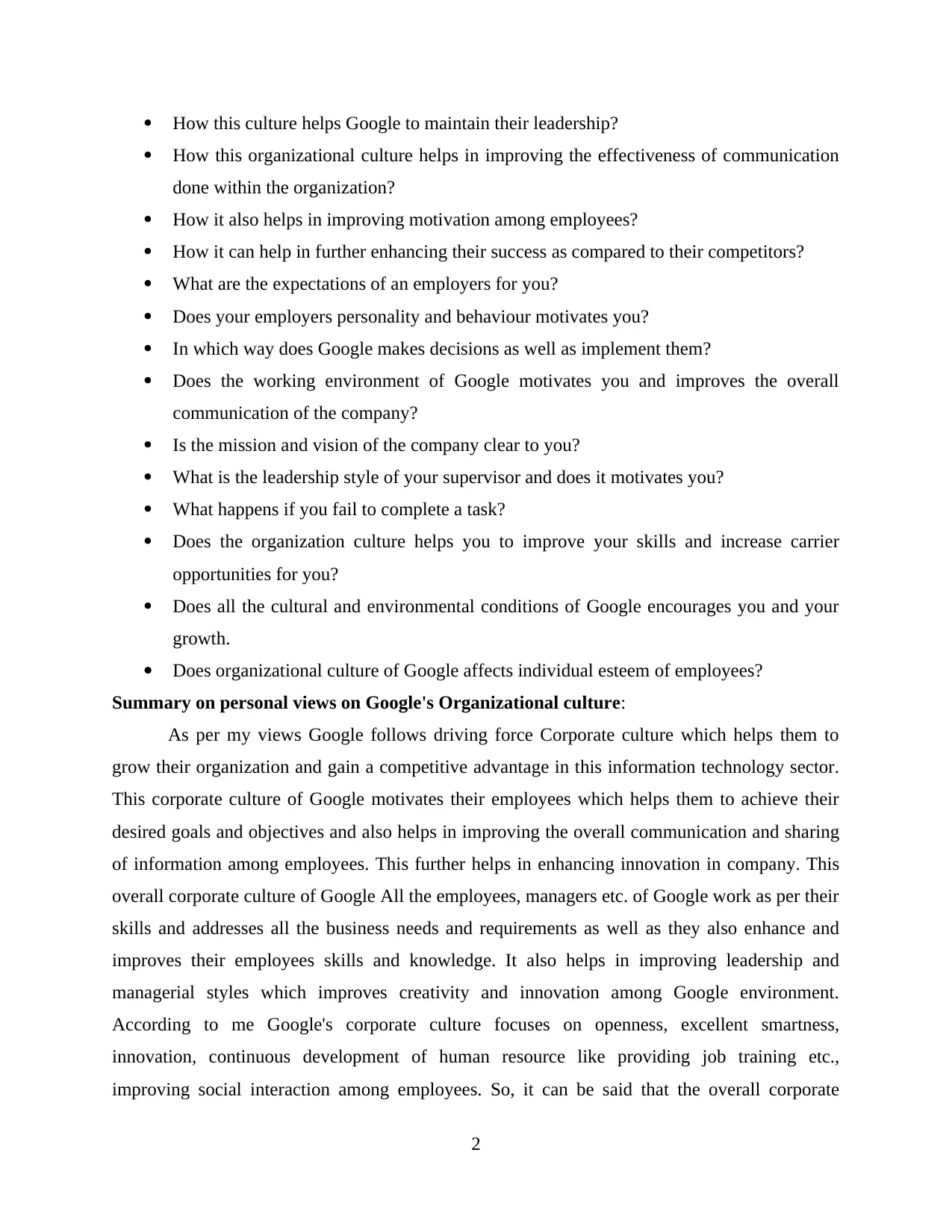
How this culture helps Google to maintain their leadership?
How this organizational culture helps in improving the effectiveness of communication
done within the organization?
How it also helps in improving motivation among employees?
How it can help in further enhancing their success as compared to their competitors?
What are the expectations of an employers for you?
Does your employers personality and behaviour motivates you?
In which way does Google makes decisions as well as implement them?
Does the working environment of Google motivates you and improves the overall
communication of the company?
Is the mission and vision of the company clear to you?
What is the leadership style of your supervisor and does it motivates you?
What happens if you fail to complete a task?
Does the organization culture helps you to improve your skills and increase carrier
opportunities for you?
Does all the cultural and environmental conditions of Google encourages you and your
growth.
Does organizational culture of Google affects individual esteem of employees?
Summary on personal views on Google's Organizational culture:
As per my views Google follows driving force Corporate culture which helps them to
grow their organization and gain a competitive advantage in this information technology sector.
This corporate culture of Google motivates their employees which helps them to achieve their
desired goals and objectives and also helps in improving the overall communication and sharing
of information among employees. This further helps in enhancing innovation in company. This
overall corporate culture of Google All the employees, managers etc. of Google work as per their
skills and addresses all the business needs and requirements as well as they also enhance and
improves their employees skills and knowledge. It also helps in improving leadership and
managerial styles which improves creativity and innovation among Google environment.
According to me Google's corporate culture focuses on openness, excellent smartness,
innovation, continuous development of human resource like providing job training etc.,
improving social interaction among employees. So, it can be said that the overall corporate
2
How this organizational culture helps in improving the effectiveness of communication
done within the organization?
How it also helps in improving motivation among employees?
How it can help in further enhancing their success as compared to their competitors?
What are the expectations of an employers for you?
Does your employers personality and behaviour motivates you?
In which way does Google makes decisions as well as implement them?
Does the working environment of Google motivates you and improves the overall
communication of the company?
Is the mission and vision of the company clear to you?
What is the leadership style of your supervisor and does it motivates you?
What happens if you fail to complete a task?
Does the organization culture helps you to improve your skills and increase carrier
opportunities for you?
Does all the cultural and environmental conditions of Google encourages you and your
growth.
Does organizational culture of Google affects individual esteem of employees?
Summary on personal views on Google's Organizational culture:
As per my views Google follows driving force Corporate culture which helps them to
grow their organization and gain a competitive advantage in this information technology sector.
This corporate culture of Google motivates their employees which helps them to achieve their
desired goals and objectives and also helps in improving the overall communication and sharing
of information among employees. This further helps in enhancing innovation in company. This
overall corporate culture of Google All the employees, managers etc. of Google work as per their
skills and addresses all the business needs and requirements as well as they also enhance and
improves their employees skills and knowledge. It also helps in improving leadership and
managerial styles which improves creativity and innovation among Google environment.
According to me Google's corporate culture focuses on openness, excellent smartness,
innovation, continuous development of human resource like providing job training etc.,
improving social interaction among employees. So, it can be said that the overall corporate
2
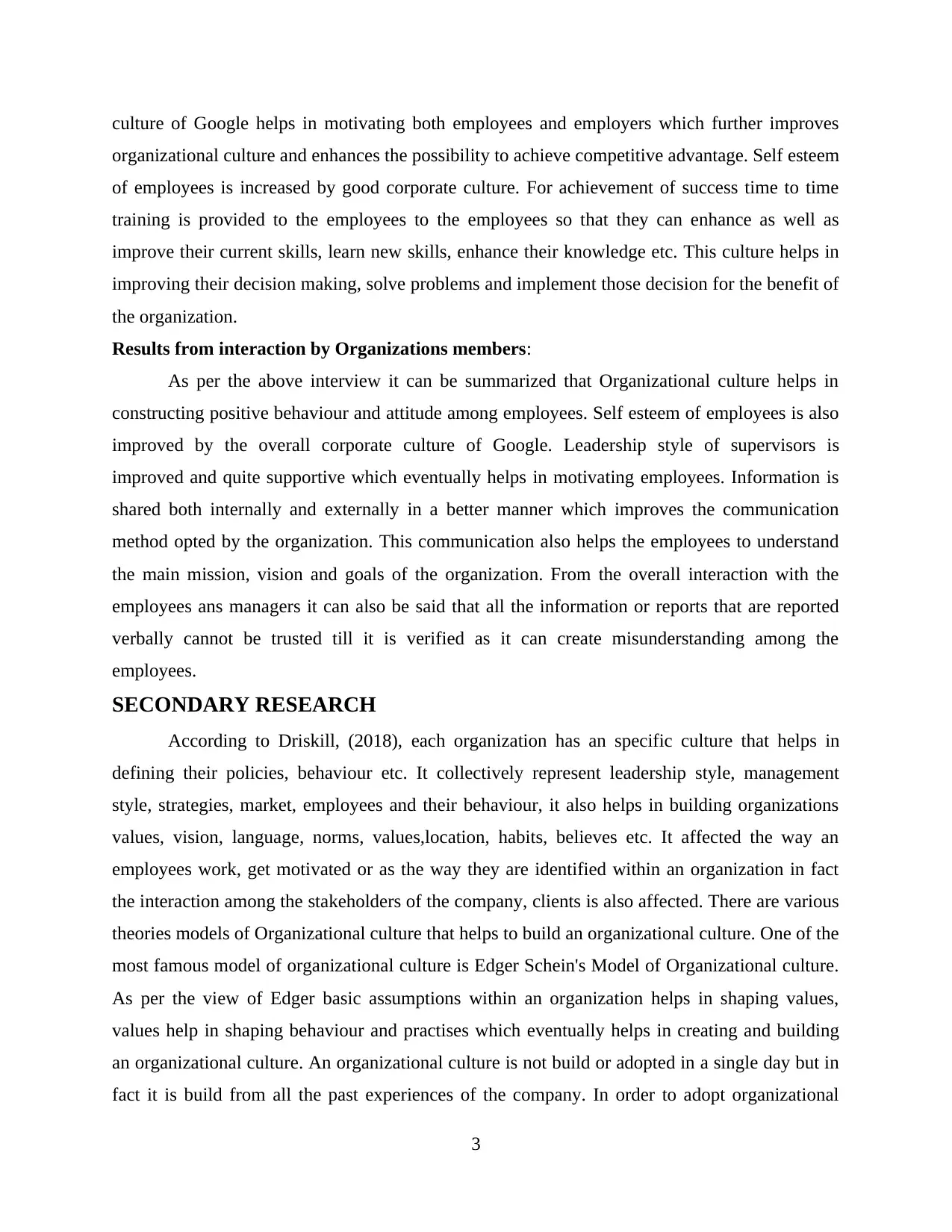
culture of Google helps in motivating both employees and employers which further improves
organizational culture and enhances the possibility to achieve competitive advantage. Self esteem
of employees is increased by good corporate culture. For achievement of success time to time
training is provided to the employees to the employees so that they can enhance as well as
improve their current skills, learn new skills, enhance their knowledge etc. This culture helps in
improving their decision making, solve problems and implement those decision for the benefit of
the organization.
Results from interaction by Organizations members:
As per the above interview it can be summarized that Organizational culture helps in
constructing positive behaviour and attitude among employees. Self esteem of employees is also
improved by the overall corporate culture of Google. Leadership style of supervisors is
improved and quite supportive which eventually helps in motivating employees. Information is
shared both internally and externally in a better manner which improves the communication
method opted by the organization. This communication also helps the employees to understand
the main mission, vision and goals of the organization. From the overall interaction with the
employees ans managers it can also be said that all the information or reports that are reported
verbally cannot be trusted till it is verified as it can create misunderstanding among the
employees.
SECONDARY RESEARCH
According to Driskill, (2018), each organization has an specific culture that helps in
defining their policies, behaviour etc. It collectively represent leadership style, management
style, strategies, market, employees and their behaviour, it also helps in building organizations
values, vision, language, norms, values,location, habits, believes etc. It affected the way an
employees work, get motivated or as the way they are identified within an organization in fact
the interaction among the stakeholders of the company, clients is also affected. There are various
theories models of Organizational culture that helps to build an organizational culture. One of the
most famous model of organizational culture is Edger Schein's Model of Organizational culture.
As per the view of Edger basic assumptions within an organization helps in shaping values,
values help in shaping behaviour and practises which eventually helps in creating and building
an organizational culture. An organizational culture is not build or adopted in a single day but in
fact it is build from all the past experiences of the company. In order to adopt organizational
3
organizational culture and enhances the possibility to achieve competitive advantage. Self esteem
of employees is increased by good corporate culture. For achievement of success time to time
training is provided to the employees to the employees so that they can enhance as well as
improve their current skills, learn new skills, enhance their knowledge etc. This culture helps in
improving their decision making, solve problems and implement those decision for the benefit of
the organization.
Results from interaction by Organizations members:
As per the above interview it can be summarized that Organizational culture helps in
constructing positive behaviour and attitude among employees. Self esteem of employees is also
improved by the overall corporate culture of Google. Leadership style of supervisors is
improved and quite supportive which eventually helps in motivating employees. Information is
shared both internally and externally in a better manner which improves the communication
method opted by the organization. This communication also helps the employees to understand
the main mission, vision and goals of the organization. From the overall interaction with the
employees ans managers it can also be said that all the information or reports that are reported
verbally cannot be trusted till it is verified as it can create misunderstanding among the
employees.
SECONDARY RESEARCH
According to Driskill, (2018), each organization has an specific culture that helps in
defining their policies, behaviour etc. It collectively represent leadership style, management
style, strategies, market, employees and their behaviour, it also helps in building organizations
values, vision, language, norms, values,location, habits, believes etc. It affected the way an
employees work, get motivated or as the way they are identified within an organization in fact
the interaction among the stakeholders of the company, clients is also affected. There are various
theories models of Organizational culture that helps to build an organizational culture. One of the
most famous model of organizational culture is Edger Schein's Model of Organizational culture.
As per the view of Edger basic assumptions within an organization helps in shaping values,
values help in shaping behaviour and practises which eventually helps in creating and building
an organizational culture. An organizational culture is not build or adopted in a single day but in
fact it is build from all the past experiences of the company. In order to adopt organizational
3
⊘ This is a preview!⊘
Do you want full access?
Subscribe today to unlock all pages.

Trusted by 1+ million students worldwide
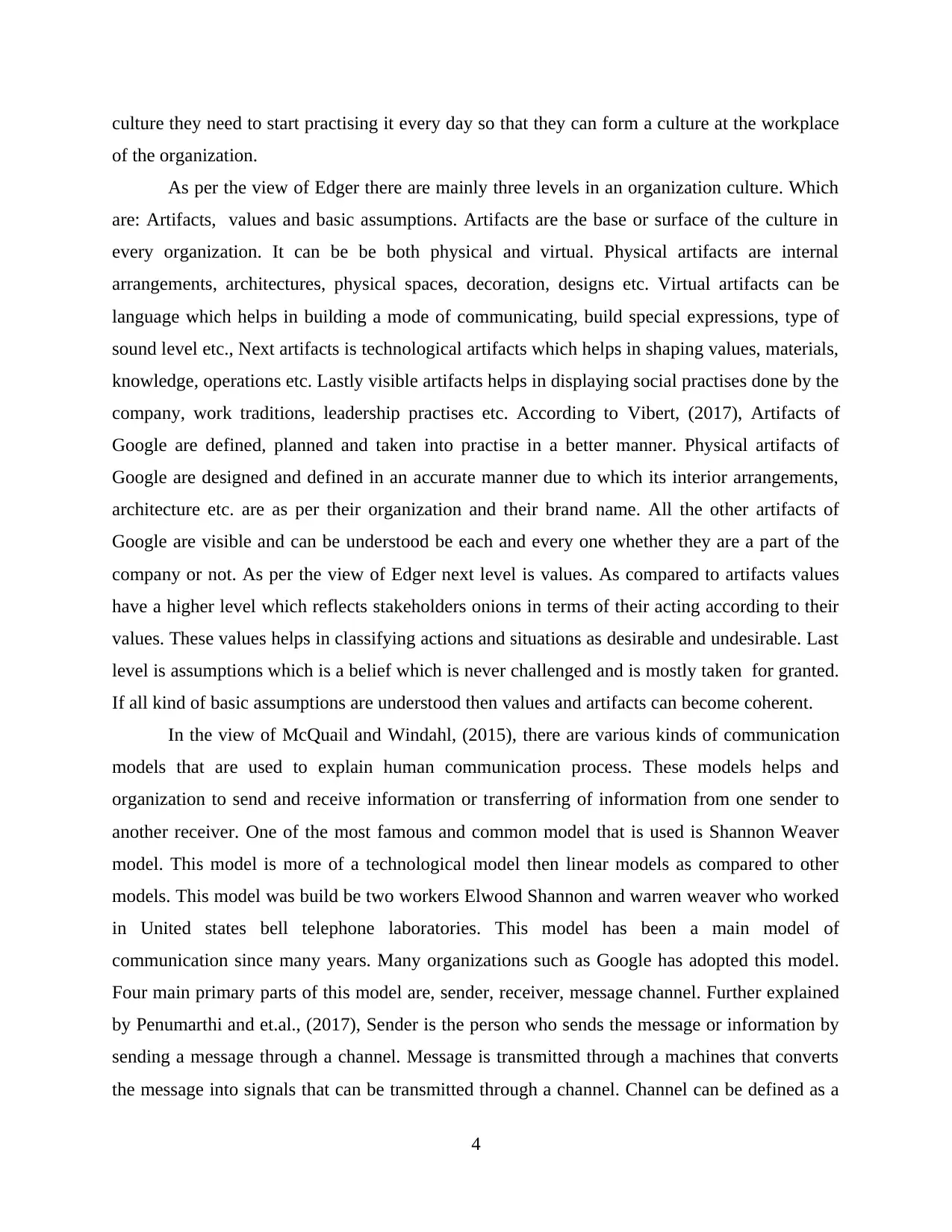
culture they need to start practising it every day so that they can form a culture at the workplace
of the organization.
As per the view of Edger there are mainly three levels in an organization culture. Which
are: Artifacts, values and basic assumptions. Artifacts are the base or surface of the culture in
every organization. It can be be both physical and virtual. Physical artifacts are internal
arrangements, architectures, physical spaces, decoration, designs etc. Virtual artifacts can be
language which helps in building a mode of communicating, build special expressions, type of
sound level etc., Next artifacts is technological artifacts which helps in shaping values, materials,
knowledge, operations etc. Lastly visible artifacts helps in displaying social practises done by the
company, work traditions, leadership practises etc. According to Vibert, (2017), Artifacts of
Google are defined, planned and taken into practise in a better manner. Physical artifacts of
Google are designed and defined in an accurate manner due to which its interior arrangements,
architecture etc. are as per their organization and their brand name. All the other artifacts of
Google are visible and can be understood be each and every one whether they are a part of the
company or not. As per the view of Edger next level is values. As compared to artifacts values
have a higher level which reflects stakeholders onions in terms of their acting according to their
values. These values helps in classifying actions and situations as desirable and undesirable. Last
level is assumptions which is a belief which is never challenged and is mostly taken for granted.
If all kind of basic assumptions are understood then values and artifacts can become coherent.
In the view of McQuail and Windahl, (2015), there are various kinds of communication
models that are used to explain human communication process. These models helps and
organization to send and receive information or transferring of information from one sender to
another receiver. One of the most famous and common model that is used is Shannon Weaver
model. This model is more of a technological model then linear models as compared to other
models. This model was build be two workers Elwood Shannon and warren weaver who worked
in United states bell telephone laboratories. This model has been a main model of
communication since many years. Many organizations such as Google has adopted this model.
Four main primary parts of this model are, sender, receiver, message channel. Further explained
by Penumarthi and et.al., (2017), Sender is the person who sends the message or information by
sending a message through a channel. Message is transmitted through a machines that converts
the message into signals that can be transmitted through a channel. Channel can be defined as a
4
of the organization.
As per the view of Edger there are mainly three levels in an organization culture. Which
are: Artifacts, values and basic assumptions. Artifacts are the base or surface of the culture in
every organization. It can be be both physical and virtual. Physical artifacts are internal
arrangements, architectures, physical spaces, decoration, designs etc. Virtual artifacts can be
language which helps in building a mode of communicating, build special expressions, type of
sound level etc., Next artifacts is technological artifacts which helps in shaping values, materials,
knowledge, operations etc. Lastly visible artifacts helps in displaying social practises done by the
company, work traditions, leadership practises etc. According to Vibert, (2017), Artifacts of
Google are defined, planned and taken into practise in a better manner. Physical artifacts of
Google are designed and defined in an accurate manner due to which its interior arrangements,
architecture etc. are as per their organization and their brand name. All the other artifacts of
Google are visible and can be understood be each and every one whether they are a part of the
company or not. As per the view of Edger next level is values. As compared to artifacts values
have a higher level which reflects stakeholders onions in terms of their acting according to their
values. These values helps in classifying actions and situations as desirable and undesirable. Last
level is assumptions which is a belief which is never challenged and is mostly taken for granted.
If all kind of basic assumptions are understood then values and artifacts can become coherent.
In the view of McQuail and Windahl, (2015), there are various kinds of communication
models that are used to explain human communication process. These models helps and
organization to send and receive information or transferring of information from one sender to
another receiver. One of the most famous and common model that is used is Shannon Weaver
model. This model is more of a technological model then linear models as compared to other
models. This model was build be two workers Elwood Shannon and warren weaver who worked
in United states bell telephone laboratories. This model has been a main model of
communication since many years. Many organizations such as Google has adopted this model.
Four main primary parts of this model are, sender, receiver, message channel. Further explained
by Penumarthi and et.al., (2017), Sender is the person who sends the message or information by
sending a message through a channel. Message is transmitted through a machines that converts
the message into signals that can be transmitted through a channel. Channel can be defined as a
4
Paraphrase This Document
Need a fresh take? Get an instant paraphrase of this document with our AI Paraphraser
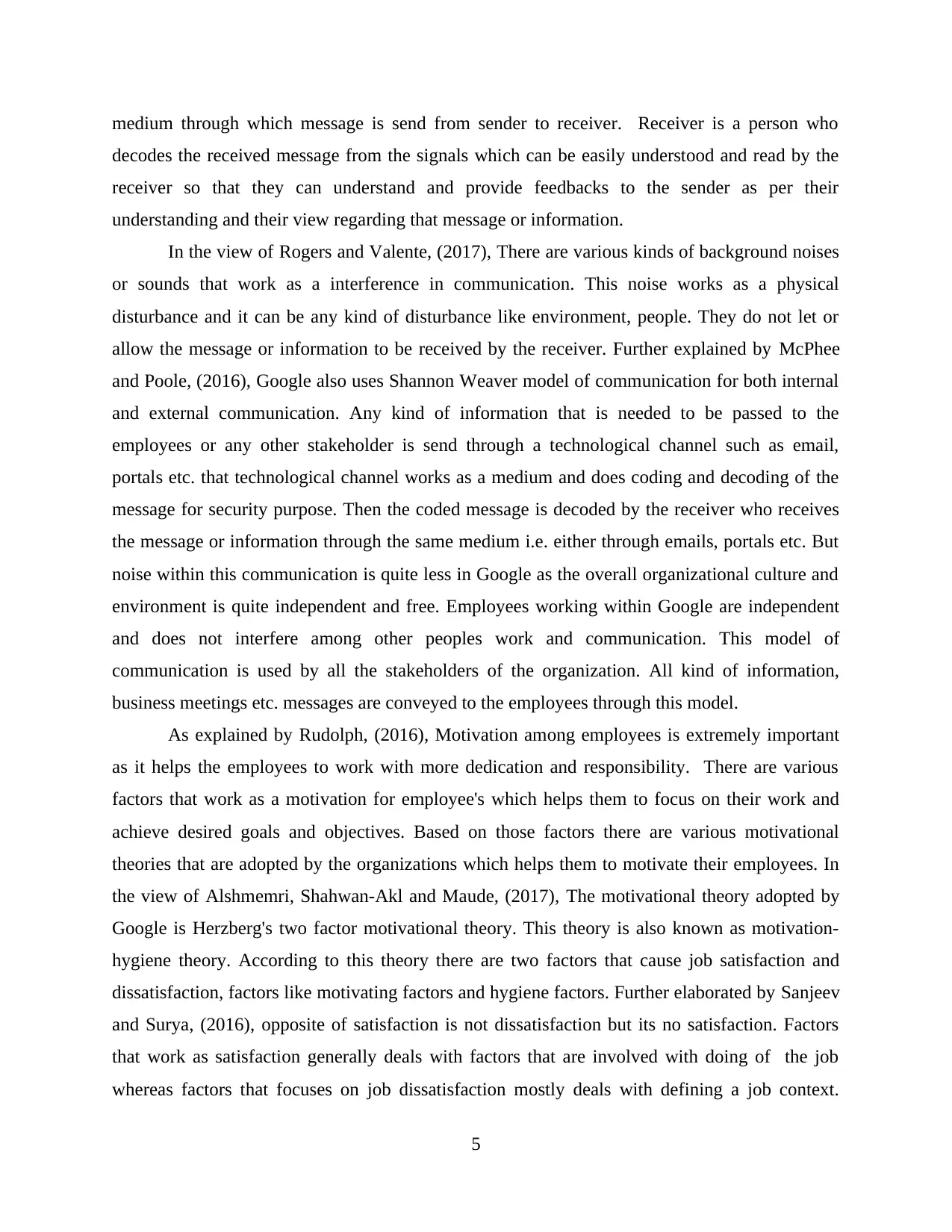
medium through which message is send from sender to receiver. Receiver is a person who
decodes the received message from the signals which can be easily understood and read by the
receiver so that they can understand and provide feedbacks to the sender as per their
understanding and their view regarding that message or information.
In the view of Rogers and Valente, (2017), There are various kinds of background noises
or sounds that work as a interference in communication. This noise works as a physical
disturbance and it can be any kind of disturbance like environment, people. They do not let or
allow the message or information to be received by the receiver. Further explained by McPhee
and Poole, (2016), Google also uses Shannon Weaver model of communication for both internal
and external communication. Any kind of information that is needed to be passed to the
employees or any other stakeholder is send through a technological channel such as email,
portals etc. that technological channel works as a medium and does coding and decoding of the
message for security purpose. Then the coded message is decoded by the receiver who receives
the message or information through the same medium i.e. either through emails, portals etc. But
noise within this communication is quite less in Google as the overall organizational culture and
environment is quite independent and free. Employees working within Google are independent
and does not interfere among other peoples work and communication. This model of
communication is used by all the stakeholders of the organization. All kind of information,
business meetings etc. messages are conveyed to the employees through this model.
As explained by Rudolph, (2016), Motivation among employees is extremely important
as it helps the employees to work with more dedication and responsibility. There are various
factors that work as a motivation for employee's which helps them to focus on their work and
achieve desired goals and objectives. Based on those factors there are various motivational
theories that are adopted by the organizations which helps them to motivate their employees. In
the view of Alshmemri, Shahwan-Akl and Maude, (2017), The motivational theory adopted by
Google is Herzberg's two factor motivational theory. This theory is also known as motivation-
hygiene theory. According to this theory there are two factors that cause job satisfaction and
dissatisfaction, factors like motivating factors and hygiene factors. Further elaborated by Sanjeev
and Surya, (2016), opposite of satisfaction is not dissatisfaction but its no satisfaction. Factors
that work as satisfaction generally deals with factors that are involved with doing of the job
whereas factors that focuses on job dissatisfaction mostly deals with defining a job context.
5
decodes the received message from the signals which can be easily understood and read by the
receiver so that they can understand and provide feedbacks to the sender as per their
understanding and their view regarding that message or information.
In the view of Rogers and Valente, (2017), There are various kinds of background noises
or sounds that work as a interference in communication. This noise works as a physical
disturbance and it can be any kind of disturbance like environment, people. They do not let or
allow the message or information to be received by the receiver. Further explained by McPhee
and Poole, (2016), Google also uses Shannon Weaver model of communication for both internal
and external communication. Any kind of information that is needed to be passed to the
employees or any other stakeholder is send through a technological channel such as email,
portals etc. that technological channel works as a medium and does coding and decoding of the
message for security purpose. Then the coded message is decoded by the receiver who receives
the message or information through the same medium i.e. either through emails, portals etc. But
noise within this communication is quite less in Google as the overall organizational culture and
environment is quite independent and free. Employees working within Google are independent
and does not interfere among other peoples work and communication. This model of
communication is used by all the stakeholders of the organization. All kind of information,
business meetings etc. messages are conveyed to the employees through this model.
As explained by Rudolph, (2016), Motivation among employees is extremely important
as it helps the employees to work with more dedication and responsibility. There are various
factors that work as a motivation for employee's which helps them to focus on their work and
achieve desired goals and objectives. Based on those factors there are various motivational
theories that are adopted by the organizations which helps them to motivate their employees. In
the view of Alshmemri, Shahwan-Akl and Maude, (2017), The motivational theory adopted by
Google is Herzberg's two factor motivational theory. This theory is also known as motivation-
hygiene theory. According to this theory there are two factors that cause job satisfaction and
dissatisfaction, factors like motivating factors and hygiene factors. Further elaborated by Sanjeev
and Surya, (2016), opposite of satisfaction is not dissatisfaction but its no satisfaction. Factors
that work as satisfaction generally deals with factors that are involved with doing of the job
whereas factors that focuses on job dissatisfaction mostly deals with defining a job context.
5
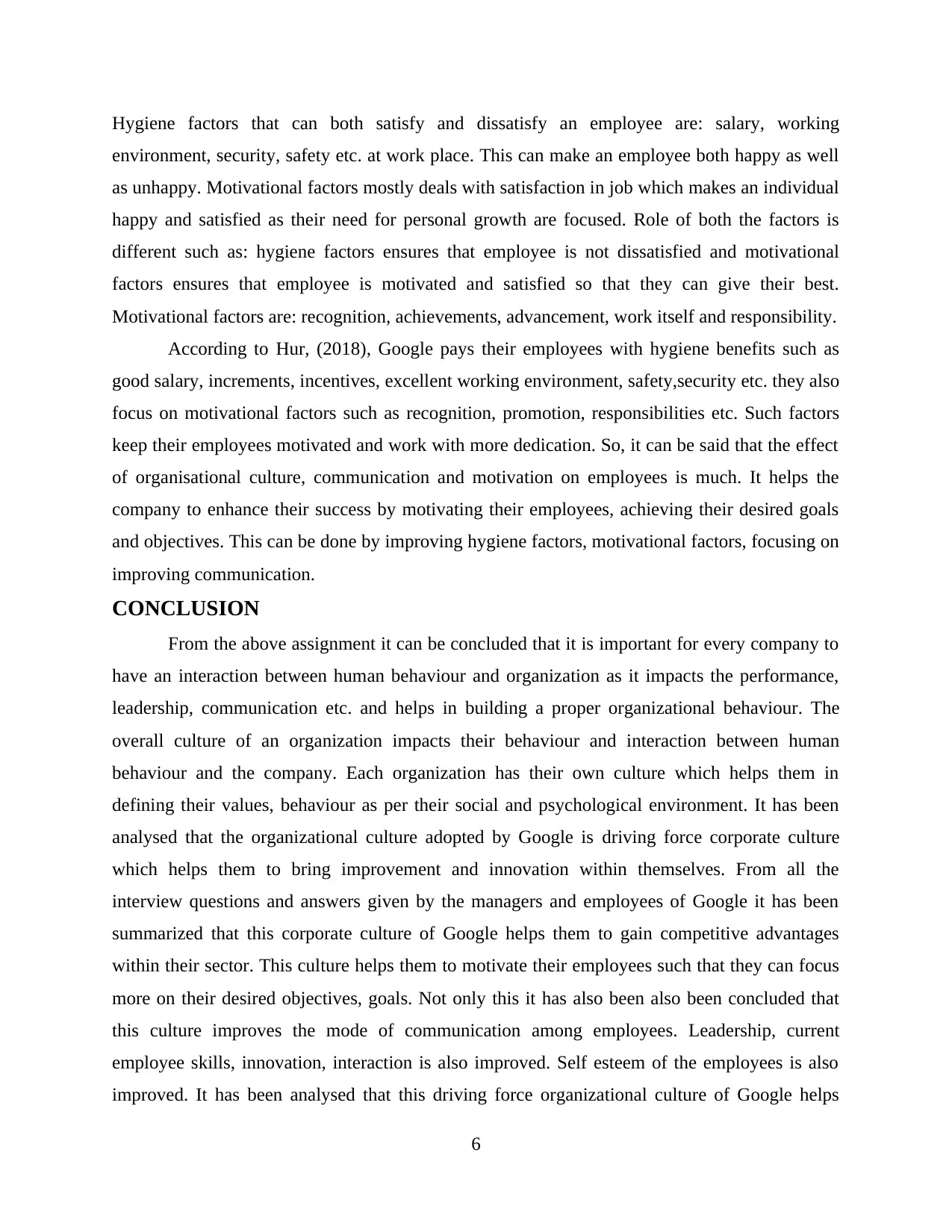
Hygiene factors that can both satisfy and dissatisfy an employee are: salary, working
environment, security, safety etc. at work place. This can make an employee both happy as well
as unhappy. Motivational factors mostly deals with satisfaction in job which makes an individual
happy and satisfied as their need for personal growth are focused. Role of both the factors is
different such as: hygiene factors ensures that employee is not dissatisfied and motivational
factors ensures that employee is motivated and satisfied so that they can give their best.
Motivational factors are: recognition, achievements, advancement, work itself and responsibility.
According to Hur, (2018), Google pays their employees with hygiene benefits such as
good salary, increments, incentives, excellent working environment, safety,security etc. they also
focus on motivational factors such as recognition, promotion, responsibilities etc. Such factors
keep their employees motivated and work with more dedication. So, it can be said that the effect
of organisational culture, communication and motivation on employees is much. It helps the
company to enhance their success by motivating their employees, achieving their desired goals
and objectives. This can be done by improving hygiene factors, motivational factors, focusing on
improving communication.
CONCLUSION
From the above assignment it can be concluded that it is important for every company to
have an interaction between human behaviour and organization as it impacts the performance,
leadership, communication etc. and helps in building a proper organizational behaviour. The
overall culture of an organization impacts their behaviour and interaction between human
behaviour and the company. Each organization has their own culture which helps them in
defining their values, behaviour as per their social and psychological environment. It has been
analysed that the organizational culture adopted by Google is driving force corporate culture
which helps them to bring improvement and innovation within themselves. From all the
interview questions and answers given by the managers and employees of Google it has been
summarized that this corporate culture of Google helps them to gain competitive advantages
within their sector. This culture helps them to motivate their employees such that they can focus
more on their desired objectives, goals. Not only this it has also been also been concluded that
this culture improves the mode of communication among employees. Leadership, current
employee skills, innovation, interaction is also improved. Self esteem of the employees is also
improved. It has been analysed that this driving force organizational culture of Google helps
6
environment, security, safety etc. at work place. This can make an employee both happy as well
as unhappy. Motivational factors mostly deals with satisfaction in job which makes an individual
happy and satisfied as their need for personal growth are focused. Role of both the factors is
different such as: hygiene factors ensures that employee is not dissatisfied and motivational
factors ensures that employee is motivated and satisfied so that they can give their best.
Motivational factors are: recognition, achievements, advancement, work itself and responsibility.
According to Hur, (2018), Google pays their employees with hygiene benefits such as
good salary, increments, incentives, excellent working environment, safety,security etc. they also
focus on motivational factors such as recognition, promotion, responsibilities etc. Such factors
keep their employees motivated and work with more dedication. So, it can be said that the effect
of organisational culture, communication and motivation on employees is much. It helps the
company to enhance their success by motivating their employees, achieving their desired goals
and objectives. This can be done by improving hygiene factors, motivational factors, focusing on
improving communication.
CONCLUSION
From the above assignment it can be concluded that it is important for every company to
have an interaction between human behaviour and organization as it impacts the performance,
leadership, communication etc. and helps in building a proper organizational behaviour. The
overall culture of an organization impacts their behaviour and interaction between human
behaviour and the company. Each organization has their own culture which helps them in
defining their values, behaviour as per their social and psychological environment. It has been
analysed that the organizational culture adopted by Google is driving force corporate culture
which helps them to bring improvement and innovation within themselves. From all the
interview questions and answers given by the managers and employees of Google it has been
summarized that this corporate culture of Google helps them to gain competitive advantages
within their sector. This culture helps them to motivate their employees such that they can focus
more on their desired objectives, goals. Not only this it has also been also been concluded that
this culture improves the mode of communication among employees. Leadership, current
employee skills, innovation, interaction is also improved. Self esteem of the employees is also
improved. It has been analysed that this driving force organizational culture of Google helps
6
⊘ This is a preview!⊘
Do you want full access?
Subscribe today to unlock all pages.

Trusted by 1+ million students worldwide
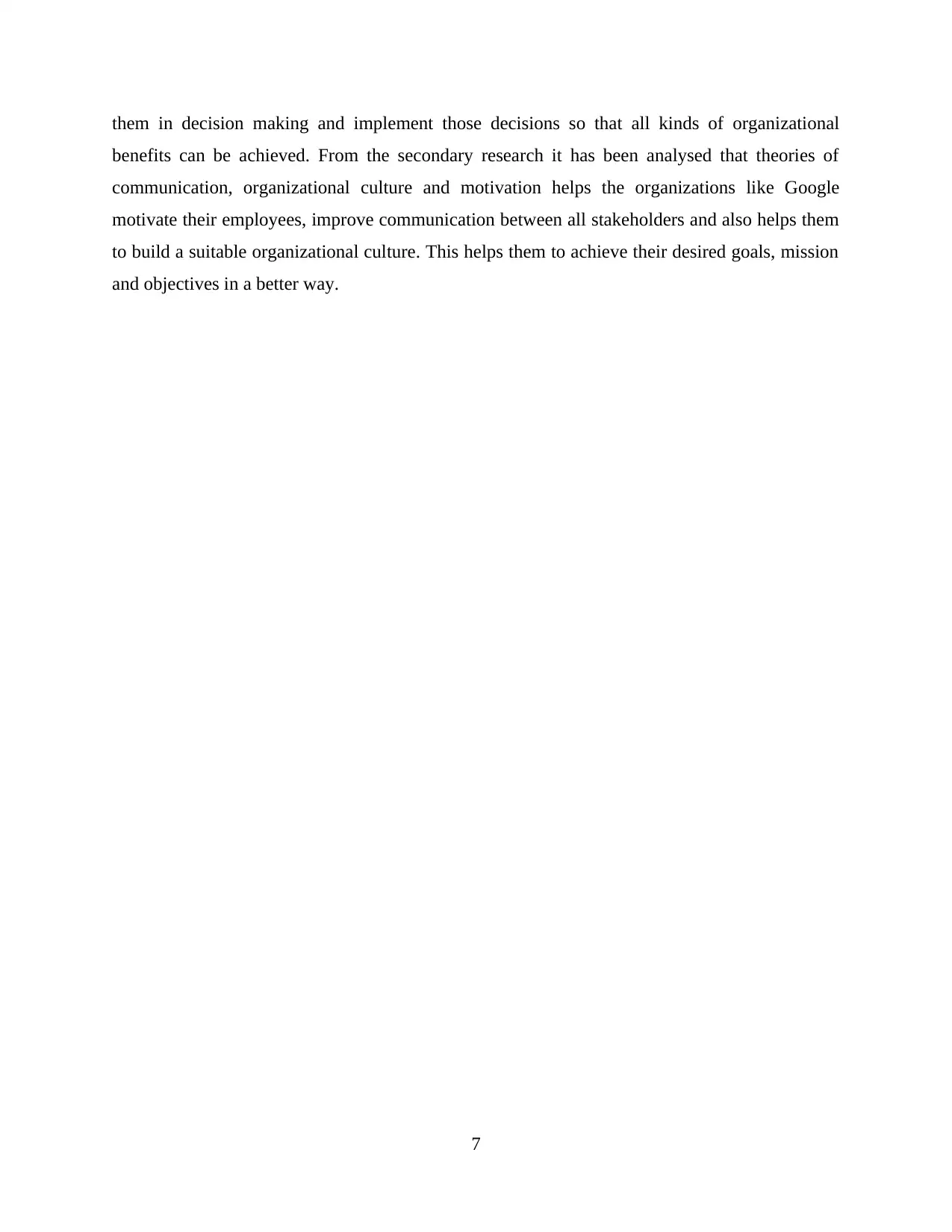
them in decision making and implement those decisions so that all kinds of organizational
benefits can be achieved. From the secondary research it has been analysed that theories of
communication, organizational culture and motivation helps the organizations like Google
motivate their employees, improve communication between all stakeholders and also helps them
to build a suitable organizational culture. This helps them to achieve their desired goals, mission
and objectives in a better way.
7
benefits can be achieved. From the secondary research it has been analysed that theories of
communication, organizational culture and motivation helps the organizations like Google
motivate their employees, improve communication between all stakeholders and also helps them
to build a suitable organizational culture. This helps them to achieve their desired goals, mission
and objectives in a better way.
7
Paraphrase This Document
Need a fresh take? Get an instant paraphrase of this document with our AI Paraphraser
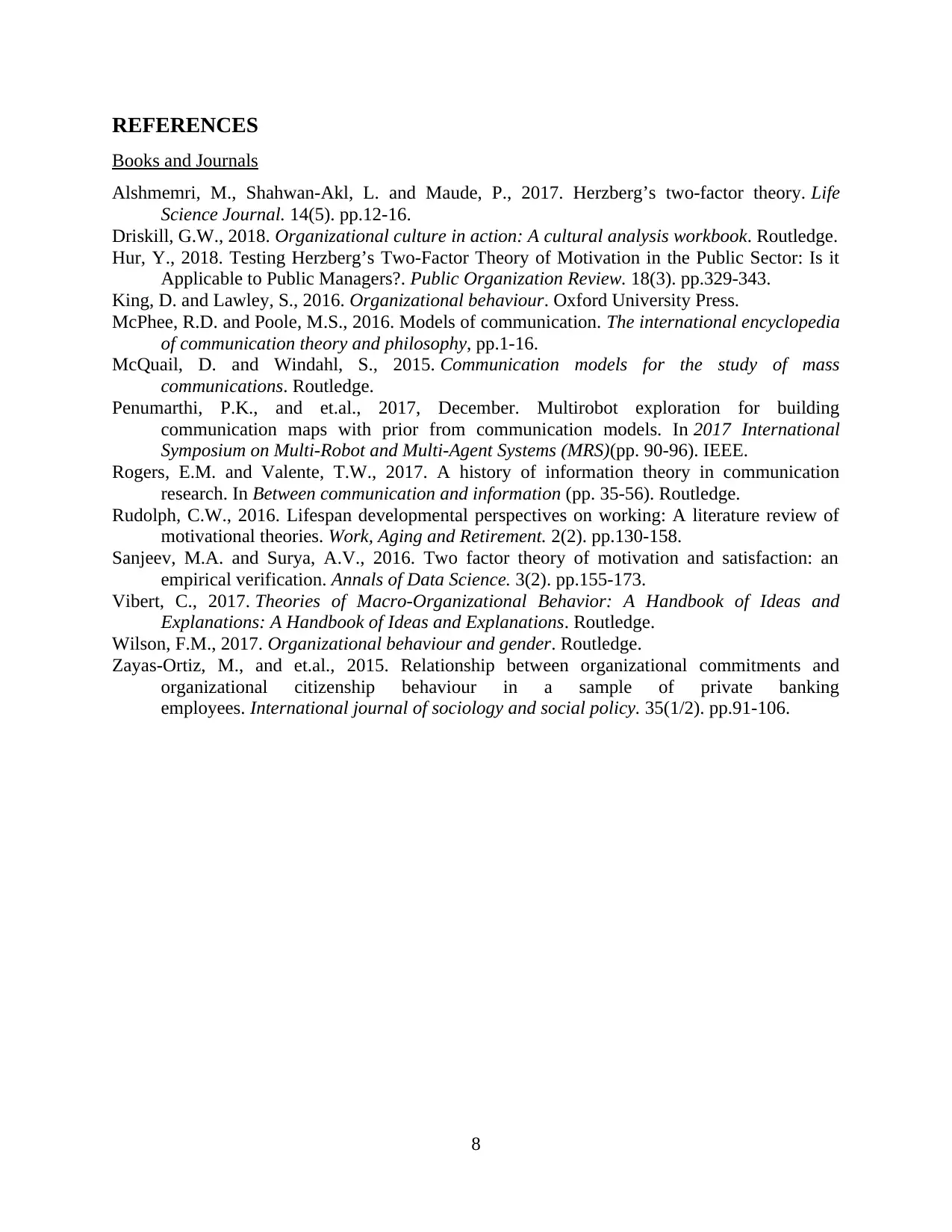
REFERENCES
Books and Journals
Alshmemri, M., Shahwan-Akl, L. and Maude, P., 2017. Herzberg’s two-factor theory. Life
Science Journal. 14(5). pp.12-16.
Driskill, G.W., 2018. Organizational culture in action: A cultural analysis workbook. Routledge.
Hur, Y., 2018. Testing Herzberg’s Two-Factor Theory of Motivation in the Public Sector: Is it
Applicable to Public Managers?. Public Organization Review. 18(3). pp.329-343.
King, D. and Lawley, S., 2016. Organizational behaviour. Oxford University Press.
McPhee, R.D. and Poole, M.S., 2016. Models of communication. The international encyclopedia
of communication theory and philosophy, pp.1-16.
McQuail, D. and Windahl, S., 2015. Communication models for the study of mass
communications. Routledge.
Penumarthi, P.K., and et.al., 2017, December. Multirobot exploration for building
communication maps with prior from communication models. In 2017 International
Symposium on Multi-Robot and Multi-Agent Systems (MRS)(pp. 90-96). IEEE.
Rogers, E.M. and Valente, T.W., 2017. A history of information theory in communication
research. In Between communication and information (pp. 35-56). Routledge.
Rudolph, C.W., 2016. Lifespan developmental perspectives on working: A literature review of
motivational theories. Work, Aging and Retirement. 2(2). pp.130-158.
Sanjeev, M.A. and Surya, A.V., 2016. Two factor theory of motivation and satisfaction: an
empirical verification. Annals of Data Science. 3(2). pp.155-173.
Vibert, C., 2017. Theories of Macro-Organizational Behavior: A Handbook of Ideas and
Explanations: A Handbook of Ideas and Explanations. Routledge.
Wilson, F.M., 2017. Organizational behaviour and gender. Routledge.
Zayas-Ortiz, M., and et.al., 2015. Relationship between organizational commitments and
organizational citizenship behaviour in a sample of private banking
employees. International journal of sociology and social policy. 35(1/2). pp.91-106.
8
Books and Journals
Alshmemri, M., Shahwan-Akl, L. and Maude, P., 2017. Herzberg’s two-factor theory. Life
Science Journal. 14(5). pp.12-16.
Driskill, G.W., 2018. Organizational culture in action: A cultural analysis workbook. Routledge.
Hur, Y., 2018. Testing Herzberg’s Two-Factor Theory of Motivation in the Public Sector: Is it
Applicable to Public Managers?. Public Organization Review. 18(3). pp.329-343.
King, D. and Lawley, S., 2016. Organizational behaviour. Oxford University Press.
McPhee, R.D. and Poole, M.S., 2016. Models of communication. The international encyclopedia
of communication theory and philosophy, pp.1-16.
McQuail, D. and Windahl, S., 2015. Communication models for the study of mass
communications. Routledge.
Penumarthi, P.K., and et.al., 2017, December. Multirobot exploration for building
communication maps with prior from communication models. In 2017 International
Symposium on Multi-Robot and Multi-Agent Systems (MRS)(pp. 90-96). IEEE.
Rogers, E.M. and Valente, T.W., 2017. A history of information theory in communication
research. In Between communication and information (pp. 35-56). Routledge.
Rudolph, C.W., 2016. Lifespan developmental perspectives on working: A literature review of
motivational theories. Work, Aging and Retirement. 2(2). pp.130-158.
Sanjeev, M.A. and Surya, A.V., 2016. Two factor theory of motivation and satisfaction: an
empirical verification. Annals of Data Science. 3(2). pp.155-173.
Vibert, C., 2017. Theories of Macro-Organizational Behavior: A Handbook of Ideas and
Explanations: A Handbook of Ideas and Explanations. Routledge.
Wilson, F.M., 2017. Organizational behaviour and gender. Routledge.
Zayas-Ortiz, M., and et.al., 2015. Relationship between organizational commitments and
organizational citizenship behaviour in a sample of private banking
employees. International journal of sociology and social policy. 35(1/2). pp.91-106.
8
1 out of 11
Related Documents
Your All-in-One AI-Powered Toolkit for Academic Success.
+13062052269
info@desklib.com
Available 24*7 on WhatsApp / Email
![[object Object]](/_next/static/media/star-bottom.7253800d.svg)
Unlock your academic potential
Copyright © 2020–2025 A2Z Services. All Rights Reserved. Developed and managed by ZUCOL.





